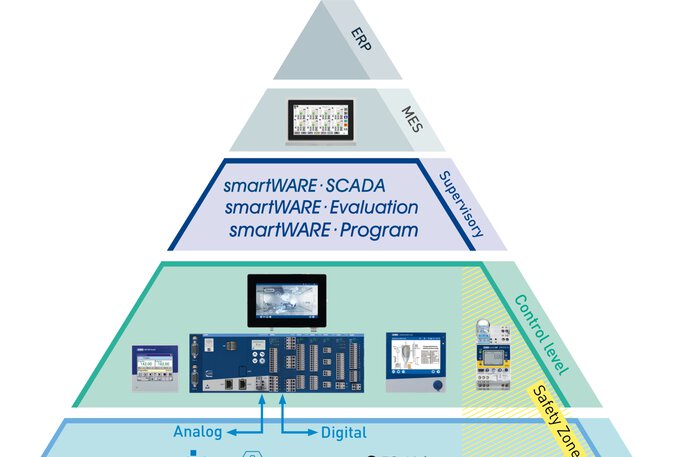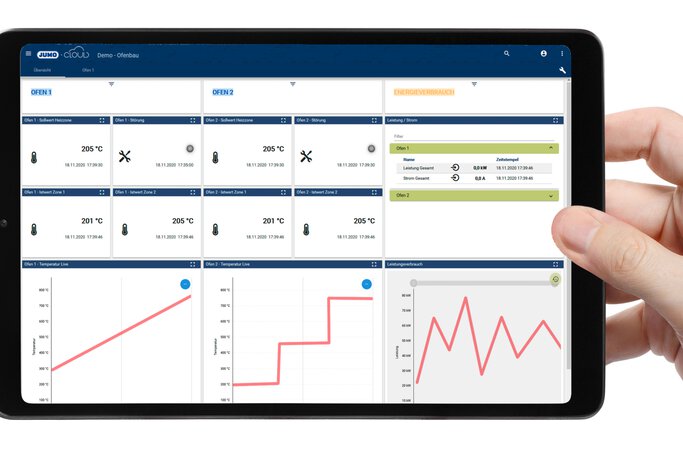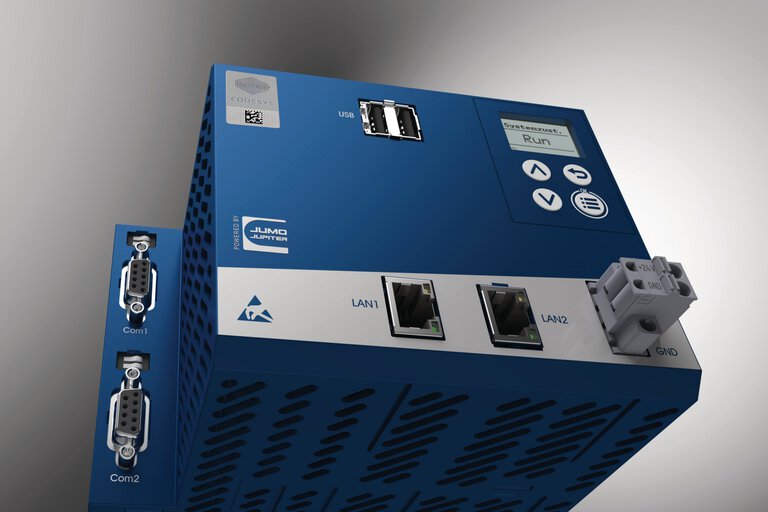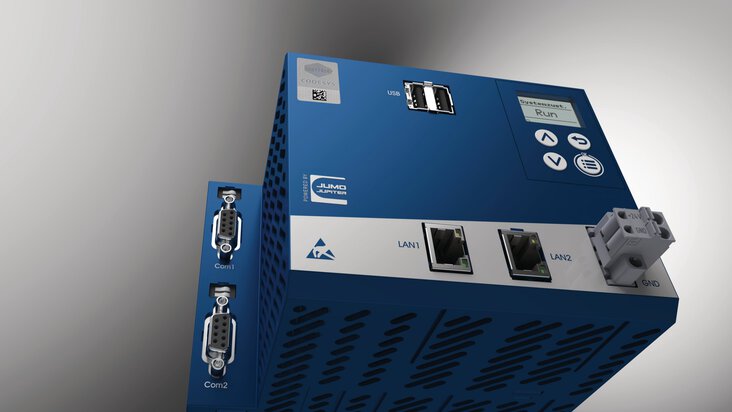
Automation systems - an overview of the most important features
As the name suggests, automation systems are used to automate processes. Automation solutions can be found in many areas of industry - e.g. in process and production technology or in logistics. Find out more about automation in industry and the scope of the components used for automation!
Table of contents
Where can automation systems be found in the automation pyramid?
Automation systems are located at the control level of the automation pyramid. They process the signals from the sensors and control the actuators. They pass data up the pyramid to the management level.

Automation pyramid
How are automation systems structured?
Automation systems are usually installed in control cabinets and can be mounted on a DIN rail. They consist of a central unit (1), which communicates with the in-/output modules (I/O-modules) (2 to 8) via the system bus.
The central unit is responsible for control and higher-level communication. All variables of the I/O-modules are available in it (such as the temperatures of the sensors at the analog inputs). A PLC is normally also used in the central processing unit, so that step sequences can be processed, for example.

Example system JUMO variTRON 500
Why do automation systems evaluate analog signals?
Automation systems control and monitor process variables. To do this, temperature, pressure, flow, humidity and other physical variables must be measured. The sensors often have internal electronics and output the measured value as a 4 to 20 mA signal. The analog inputs of an automation system must therefore at least be able to evaluate current signals.
The I/O-module (3) shown has 4 universal inputs for receiving current signals (4 to 20 mA) but is also suitable for receiving resistance thermometers and thermocouples. The 2nd analog input module (4) can accept 8 resistance thermometers.
As a rule, binary signals such as the status of thermostats, pressure switches and proximity sensors must also be connected to the systems. The hardware must also be available for this purpose (6 + 7).
Why do automation systems have analog and binary outputs?
Automation systems often influence process variables. Heating, humidification and, for example, an inverter for changing the speed of a motor must be operated. Actuation usually takes place via a current signal (4 to 20 mA), which means that the interface modules must provide analog outputs (5).
Actuators are also operated via binary outputs such as relay outputs (8) or logic outputs (6 + 7).
How are process variables kept constant?
Process variables must be present at different levels in the process steps (e.g. 120 °C, 3 bar or 270 l/h). The central unit must specify the corresponding setpoints and controllers must ensure that the variables in the system are regulated by operating heaters, compressors and pumps. In many systems, the controllers are implemented in the PLC - these are then so-called software controllers. However, the system shown here has hardware controllers (2). This concept has two advantages: The controllers regulate to the last setpoint even if the PLC fails (higher process reliability); the actual and setpoint values do not have to be transferred between the PLC and the controllers in the cycle of the sampling time (reduction of the bus cycle time).
What are decentralized automation systems?
The structure of the illustrated system is centralized. All sensor/actuator cables must be routed centrally to the system's control cabinet. However, imagine a sub-system that is located around 50 meters away from the control cabinet. In this scenario, a great wiring effort is needed - especially if the sensors and actuators communicate analog. For this reason, it is possible in many automation systems to place some of the I/O-modules in a sub-distribution board and connect them to the main system via the system bus. This turns a central automation system into a decentralized system and reduces the wiring effort.
Why is visualization needed and how does it work?
Effective process automation requires consistent system monitoring so that the system must be displayed with all process variables. It must also be possible to make changes in the visualization, such as setting a different setpoint. In the example system, the visualization is set up in the implemented PLC. All end devices that are in the same network as the LAN interface of the central unit can call up the visualization or the web server of the PLC. End devices can be browser applications or web panels.
Visualization or control should often be possible worldwide on different end devices. For this purpose, the system can be accessed in a cloud application via a PC or smartphone.

Visualization via web panel

Visualization on the tablet
How are automation systems programmed?
An automation system usually has a PLC, which is programmed in a programming language such as CFC or ST code. This links the signals of the I/O-modules (which receive signals) and operates I/O-modules (which have outputs). This is how the PLC implements sequence control, for example.
Implementing a complete automation solution is very extensive. To simplify the setup, a configuration program exists for the example system, which can make basic settings such as adapting the analog inputs to the sensors and the functions of the controller modules. The project is then expanded via the PLC - sample projects containing a visualization are used here. This procedure makes setting up the automation system significantly less time-consuming.
What else does automation technology need to achieve?
In many applications, it must be possible to trace the course of the process variables temperature, pressure, humidity, etc. during the production process. Therefore, all relevant variables must be recorded and traceable, for example with the help of an order number.
The sample system transmits the recorded measured values to a server via the network. The server can be accessed via a browser application on all PCs in the same network, so that data can be analyzed as shown in the graphic below.
Furthermore, an automation system must be accessible by other systems via an interface. The example system can therefore communicate via a LAN interface (network), via PROFINET or via serial interfaces.

Data evaluation via browser application
- ${title}${badge}


